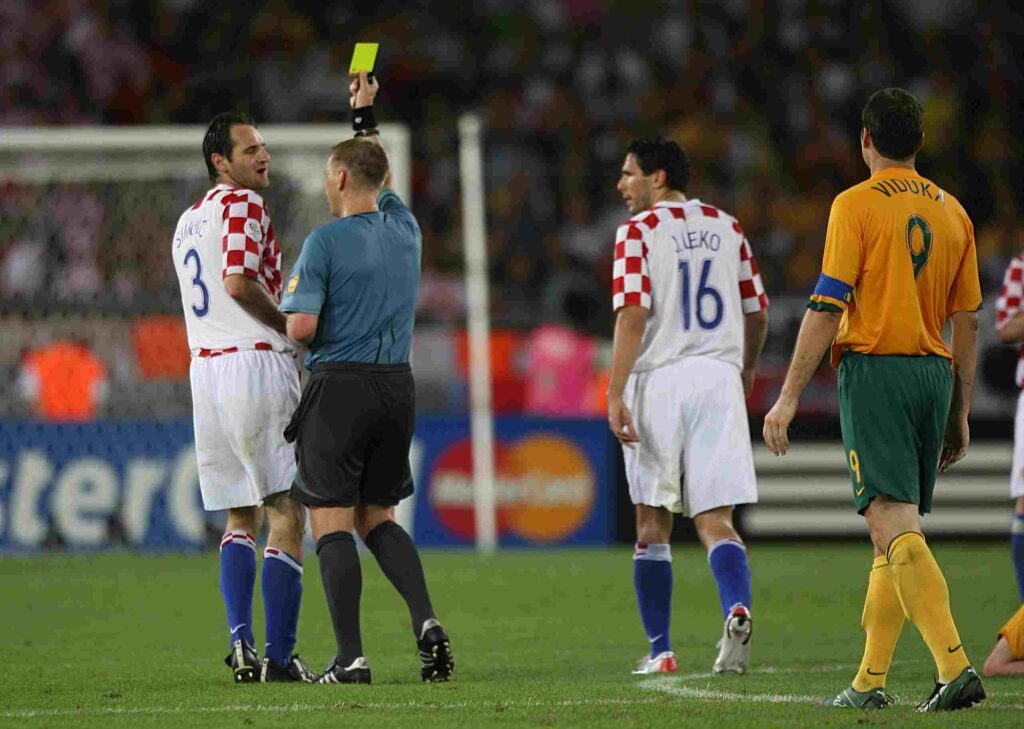If you’ve ever played football, you know how the yellow card system works. Get a yellow card, and it’s a warning. Get another one, and you’re shown a red card, which means you’re done for the day, headed straight for the locker room.
But what if a player gets three yellow cards? That’s impossible, right? Well, not exactly. It’s actually happened once, and only once, in the entire history of the FIFA World Cup.
Let’s dive into the bizarre and unforgettable story of when referee Graham Poll handed out three yellow cards in a single match.
Understanding Yellow Cards in Football
Before we jump into the details, let’s break down the rules about yellow and red cards in football, just to make sure we’re on the same page.
What is a Yellow Card?
A yellow card is basically a caution from the referee to a player. It’s the official way of saying, “Watch it, you’re on thin ice!” A player can receive a yellow card for things like:
- A reckless tackle
- Time-wasting
- Arguing too much with the ref
- Faking an injury (a.k.a. diving)
If a player gets two yellow cards in one match, they’re shown a red card and immediately sent off. After the second yellow, the team has to finish the game with one less player.
When the System Fails – The Three Yellow Card Incident
So, the rules are pretty simple, right? But what happens when a referee gives out three yellow cards to the same player? Well, that’s what happened in the 2006 World Cup, and it’s an incident that football fans will never forget.
The Game: Australia vs Croatia, 2006 World Cup
The moment in question happened in a match between Australia and Croatia during the group stages of the 2006 FIFA World Cup in Germany. It was the final group game, and both teams were fighting for a spot in the knockout rounds.
The match ended in a 2-2 draw, but the real drama was not in the scoreline—it was in the strange incident involving Croatian defender Josip Šimunić, who somehow managed to get three yellow cards before being sent off.
Graham Poll – The Man Behind the Whistle
Before we get into the specifics of the match, let’s talk about Graham Poll, the referee who made the infamous blunder.
Poll was one of the most respected referees in English football, having officiated in the Premier League for over 26 years. He had more than 1,500 matches under his belt, including high-stakes international games. In fact, Poll had been trusted to referee at the World Cup twice—first in 2002 and again in 2006.
But despite his glowing career, he will forever be remembered for one thing: the referee who gave out three yellow cards in one game.
What Happened During the Game?

Here’s a blow-by-blow account of how it all unfolded:
The First Yellow Card –
In the 61st minute of the match, Poll showed his first yellow card to Josip Šimunić for a rough tackle on one of the Australian players.
So far, everything was normal. A yellow card was shown, the game moved on.
The Second Yellow Card –
Fast forward to the 90th minute. Šimunić, who had already been booked, made another challenge, and Poll pulled out his yellow card again.
At this point, Šimunić should have been shown a red card and sent off. But Poll didn’t realize this. He just recorded the yellow card and let Šimunić continue playing.
The Third Yellow Card –
After the final whistle, Šimunić, furious about the game’s outcome, confronted Poll. In the heat of the moment, he pushed the referee, which is an automatic yellow card offence.
Poll, oblivious to the fact that he’d already booked Šimunić twice, showed him a third yellow card—finally followed by the red card!
By this point, it was too late. The match was over, but Poll’s mistake had already been broadcast to millions of people around the world.
How Did This Happen?
You might be wondering, “How does a referee with so much experience make such a massive mistake?”
Well, it turns out that it wasn’t just a brain slip by Poll. There was a reason behind the confusion, and it has to do with the player, Josip Šimunić, himself.
Šimunić, while playing for Croatia, was born in Australia and had an Australian accent.
In the chaos of a World Cup match, Poll mistakenly noted the first yellow card under the Australian column rather than the Croatian one.
By the time the second yellow card was handed out, Poll didn’t realize that Šimunić had already been booked, because in his notes, it looked like two different players had been cautioned.
The Fallout from the Incident
Once the match ended and the mistake was revealed, Poll was devastated. He owned up to his error immediately and requested to leave the tournament.
FIFA allowed him to withdraw, and his international refereeing career came to a swift and unfortunate end.
Poll later explained how this mix-up happened in interviews, pointing out the confusion caused by Šimunić’s Australian background.
But by then, the damage was done. His reputation as one of the top referees in the world had been permanently tainted.
Did the Mistake Affect the Outcome of the Game?
Fortunately, despite Poll’s error, the mistake did not change the outcome of the match. Australia advanced to the knockout stage while Croatia was eliminated, and the game itself finished in a 2-2 draw.
However, had Šimunić been sent off after the second yellow card, who knows how the final few minutes might have played out?
It’s one of those “what if” moments in football that fans will debate for years.
Why It’s So Memorable
In the grand history of the World Cup, Graham Poll’s mistake stands out because it’s so rare. Referees have a tough job, and they’re often criticized when things go wrong.
But giving out three yellow cards to the same player? That’s something that had never happened before, and it hasn’t happened since.
Poll’s blunder will always be part of World Cup folklore, a strange but fascinating footnote in football history.
Moving On
Despite the blunder, Graham Poll continues to be a respected figure in football. He’s since moved on to other ventures, including media work and giving back to the game through his experiences.
Everyone makes mistakes, even those at the very top of their field. What matters is how you recover from them.
Conclusion
The story of the “three yellow cards” will always be one of the most memorable moments in World Cup history.
It’s a story that young football fans like you can learn from—whether you’re a player, a fan, or maybe even an aspiring referee. Mistakes happen, but the game always moves forward.
So next time you see a yellow card flash on the screen, just remember: it could be worse. You could get three of them in one match!



